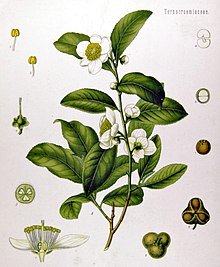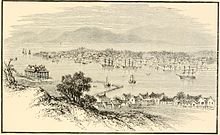Hello Steemins!
I Will Give You some information about tea.
Tea is an aromatic Beverage. Prepared by pouring hot are boiling water over cured leaves of the Camellia sinensis, an evergreen shrub (bush) native to Asia.
.jpg)
Tea originated in Southwest China, where it was used as a medicinal drink. It was popularized as a recreational drink during the Chinese Tang dynasty, and tea drinking spread to other East Asian countries. Portuguese priests and merchants introduced it to Europe during the 16th century. During the 17th century, drinking tea became fashionable among Britons, who started large-scale production and commercialization of the plant in India to bypass the Chinese monopoly.
The term herbal tea refers to drinks not made from Camellia sinensis: infusions of fruit, leaves, or other parts of the plant, such as steeps of rosehip, chamomile, or rooibos. These are sometimes called tisanes or herbal infusions to prevent confusion with tea made from the tea plant.

The Chinese character for tea is 茶, originally written with an extra stroke as 荼 (pronounced tú, used as a word for a bitter herb), and acquired its current form during the Tang Dyna The word is pronounced differently in the different varieties of Chinese, such as chá in Mandarin, zo and dzo in Wu Chinese, and ta and te in Min Chinese. One suggestion is that the different pronunciations may have arisen from the different words for tea in ancient China, for example tú (荼) may have given rise to tê; historical phonologists however argued that the cha, te and dzo all arose from the same root with a reconstructed pronunciation dra, which changed due to sound shift through the centuries.
There were other ancient words for tea, though ming (茗) is the only other one still in common use. It has been proposed that the Chinese words for tea, tu, cha and ming, may have been borrowed from the Austro-Asiatic languages of people who inhabited southwest China; cha for example may have been derived from an archaic Austro-Asiatic root *la, meaning "leaf". Most Chinese languages, such as Mandarin and Cantonese, pronounce it along the lines of cha, but Hokkien and Teochew Chinese varieties along the Southern coast of China pronounce it like teh. These two pronunciations have made their separate ways into other languages around the world.
Starting in the early 17th century, the Dutch played a dominant role in the early European tea trade via the Dutch East India Company. The Dutch borrowed the word for "tea" (thee) from Min Chinese, either through trade directly from Hokkien speakers in Formosa where they had established a port, or from Malay traders in Bantam, Java. The Dutch then introduced to other European languages this Min pronunciation for tea, including The Cha pronunciation came from the Cantonese chàh of Guangzhou (Canton) and the ports of Hong Kong and Macau, which were also major points of contact, especially with the Portuguese traders who settled Macau in the 16th century. The Portuguese adopted the Cantonese pronunciation "chá", and spread it to India However, the Korean and Japanese pronunciations of cha were not from Cantonese, but were borrowed into Korean and Japanese during earlier periods of Chinese history.

A third form, the increasingly widespread chai, came from Persian چای [t͡ʃɒːi] chay. Both the châ and chây forms are found in Persian dictionaries. They are derived from the Northern Chinese pronunciation of chá which passed overland to Central Asia and Persia, where it picked up the Persian grammatical suffix -yi before passing on to Russian as чай ([tɕæj], chay), Arabic as شاي (pronounced shay [ʃæiː] due to the lack of a /t͡ʃ/ sound in Arabic), Urdu as چائے chay, Hindi as चाय chāy, Turkish as çay, etc. The few exceptions of words for tea that do not fall into the three broad groups of te, cha and chai are mostly from the minor languages from the botanical homeland of the tea plant from which the Chinese words for tea might have been borrowed originally. English has all three forms: cha or char (both pronounced attested from the 16th century; tea, from the 17th; and chai, from the 20th. However, the form chai refers specifically to a
_derivative.jpg)
History of tea
A 19th-century Japanese painting depicting Shennong: Chinese legends credit Shennong with the invention of tea.
Tea plants are native to East Asia, and probably originated in the borderlands of north Burma and southwest China.Statistical cluster analysis, chromosome number, easy hybridization, and various types of intermediate hybrids and spontaneous polyploids indicate that likely a single place of origin exists for Camellia sinensis, an area including the northern part of Burma, and Yunnan and Sichuan provinces of China. Tea drinking may have begun in the Yunnan region during the Shang Dynasty in China, when it was used for medicinal purposes. It is also believed that in Sichuan, "people began to boil tea leaves for consumption into a concentrated liquid without the addition of other leaves or herbs, thereby using tea as a bitter yet stimulating drink, rather than as a medicinal concoction."
Chinese legends attribute the invention of tea to Shennong in 2737 BC, although evidence suggests that tea drinking may have been introduced from the southwest of China (Sichuan/Yunnan area). The earliest written records of tea come from China. The word tú 荼 appears in the Shijing and other ancient texts to signify a kind of "bitter vegetable" (苦菜), and it is possible that it referred to a number of different plants such as sowthistle, chicory, or smartweed, as well as tea. In the Chronicles of Huayang, it was recorded that the Ba people in Sichuan presented tu to the Zhou king. The state of Ba and its neighbour Shu were later conquered by the Qin, and according to the 17th century scholar Gu Yanwu who wrote in Ri Zhi Lu (日知錄): "It was after the Qin had taken Shu that they learned how to drink tea."Another possible early reference to tea is found in a letter written by the Qin Dynasty general Liu Kun who requested that some "real tea" to be sent to him.
The earliest known physical evidenc of tea was discovered in 2016 in the mausoleum of Emperor Jing of Han in Xi'an, indicating that tea from the genus Camellia was drunk by Han Dynasty emperors as early as the 2nd century BC.The Han dynasty work "The Contract for a Youth", written by Wang Bao in 59 BC contains the first known reference to boiling tea. Among the tasks listed to be undertaken by the youth, the contract states that "he shall boil tea and fill the utensils" and "he shall buy tea at Wuyang". The first record of tea cultivation is also dated to this period (the reign of Emperor Xuan of Han), during which tea was cultivated on Meng Mountain (蒙山) near Chengdu. Another early credible record of tea drinking dates to the third century AD, in a medical text by Hua Tuo, who stated, "to drink bitter t'u constantly makes one think better.However, before the mid-8th century Tang dynasty, tea-drinking was primarily a southern Chinese practice.It became widely popular during the Tang Dynasty, when it was spread to Korea, Japan, and Vietnam. In India, tea has been drunk for medicinal purposes for a long but uncertain period, but apart from the Himalayan region it seems not to have been used as a beverage until the British introduced tea-drinking there much later.
Hi! I am a robot. I just upvoted you! I found similar content that readers might be interested in:
https://en.wikipedia.org/wiki/Tea
Congratulations @seeinheart! You have completed some achievement on Steemit and have been rewarded with new badge(s) :
Click on any badge to view your own Board of Honor on SteemitBoard.
For more information about SteemitBoard, click here
If you no longer want to receive notifications, reply to this comment with the word
STOPCongratulations @seeinheart! You received a personal award!
Click here to view your Board
Congratulations @seeinheart! You received a personal award!
You can view your badges on your Steem Board and compare to others on the Steem Ranking
Vote for @Steemitboard as a witness to get one more award and increased upvotes!